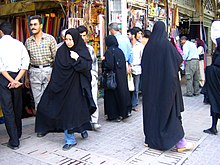Chador

The chador , formerly also ( Georgian ) the chadra ( Persian چادر Tschādor , DMG čādor , 'tent'), is a large, mostly dark cloth in the form of a fringed semicircle, which iswrapped around the head and body as a cloak, especially by Muslim women in Iran , and only leaves the face or parts of the face free. In the Iranian public, it is worn over other clothing, mainly by conservative women.
The motives for wearing the chador are diverse and also change with the social and political situation. From December 1936, for example, Reza Shah Pahlavi prohibited wearing this garment by edict . At the time of Shah Mohammad Reza Pahlavi , women in Iran also wore the chador to set an example against the loss of the Islamic way of life. In the First Gulf War between Iraq and Iran, the chador expressed national unity. After the Islamic Revolution , the state-imposed obligation to wear a form of hijab became increasingly tiresome and is now seen as a sign of particular religious rigor. Many Iranian women register insteadHeadscarf and a light coat (manto or abaya ), which often only has an alibi function. Young women from the urban milieu in particular often wear coats that are tighter and just below the knees. A scarf covering their hair ( chimar ) often slips “accidentally” down onto their shoulders.
The chador is compulsory for some professions in Iran, is part of the school uniform in some schools and is common when entering mosques . Another form of chador is the prayer chador. It is mostly made of light-ground fabric with a subtle pattern and is used in prayer. In the 1960s, especially in rural areas, it was common for women to wear the prayer chador as a cover over their “western” clothing and not wear a headscarf or the coat that has been prescribed since the revolution (manto, see headscarf dispute ).
See also
Web links
Individual evidence
- ↑ The songs of Mirza-Schaffy with a prologue by Friedrich Bodenstedt. 152nd ed., R. v. Decker's Verlag, Berlin 1896, p. 98
- ↑ Christopher de Bellaigue: In the rose garden of the martyrs. A portrait of Iran. From the English by Sigrid Langhaeuser, Verlag CH Beck, Munich 2006 (English original edition: London 2004), p. 118 f.
